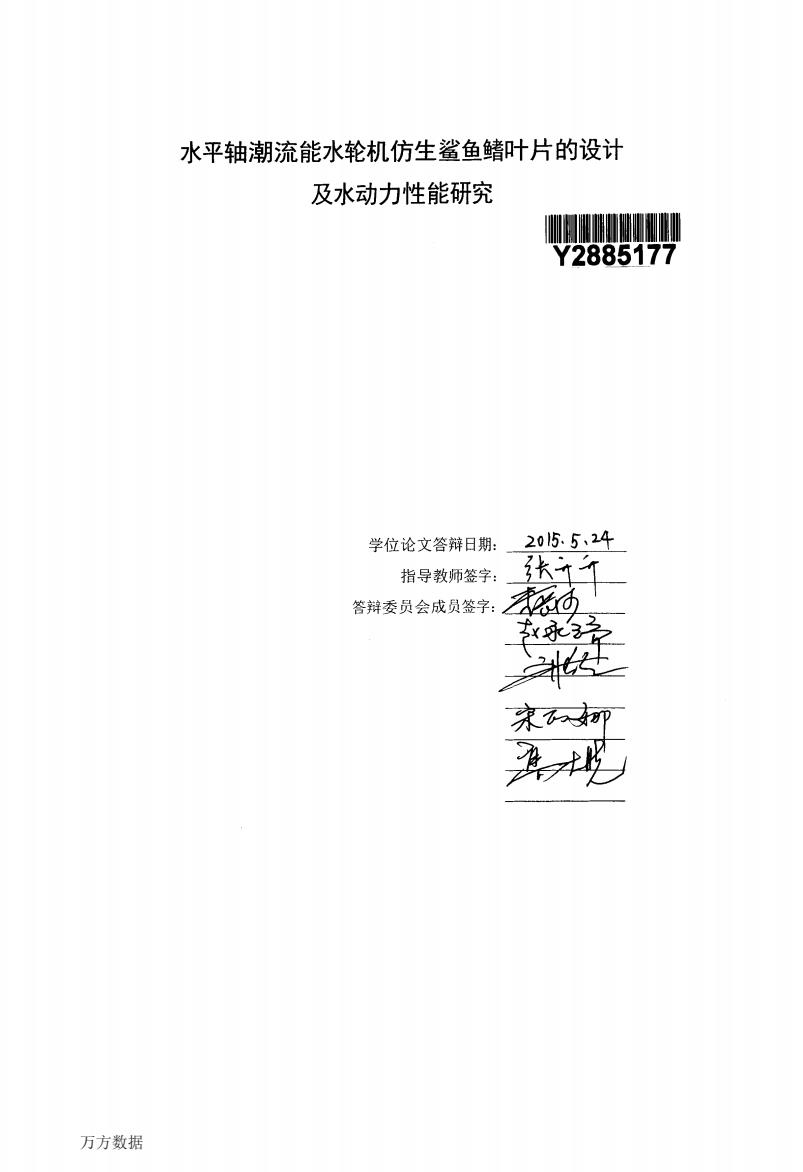
水平轴潮流能水轮机仿生鲨鱼鳍叶片的设计 及水动力性能研究 Y72885177 学位论文答辩日期: 2015.5、24 指导教师签字: 张 答辩委员会成员签字: 万方数据
水平轴潮流能水轮机仿生鲨鱼鳍叶片的设计 及水动力性能研究 ilillli ii HiiM iiiM Y2885177 学位论文答辩日期: 指导教师签字: 答辩委员会成员签字: 20限F、珥 万方数据

谨以此论文献给所有关心帮助过我的师长和同窗 一高振 万方数据
谨以此论文献给所有关心帮助过我的师长和同窗 一高振 万方数据
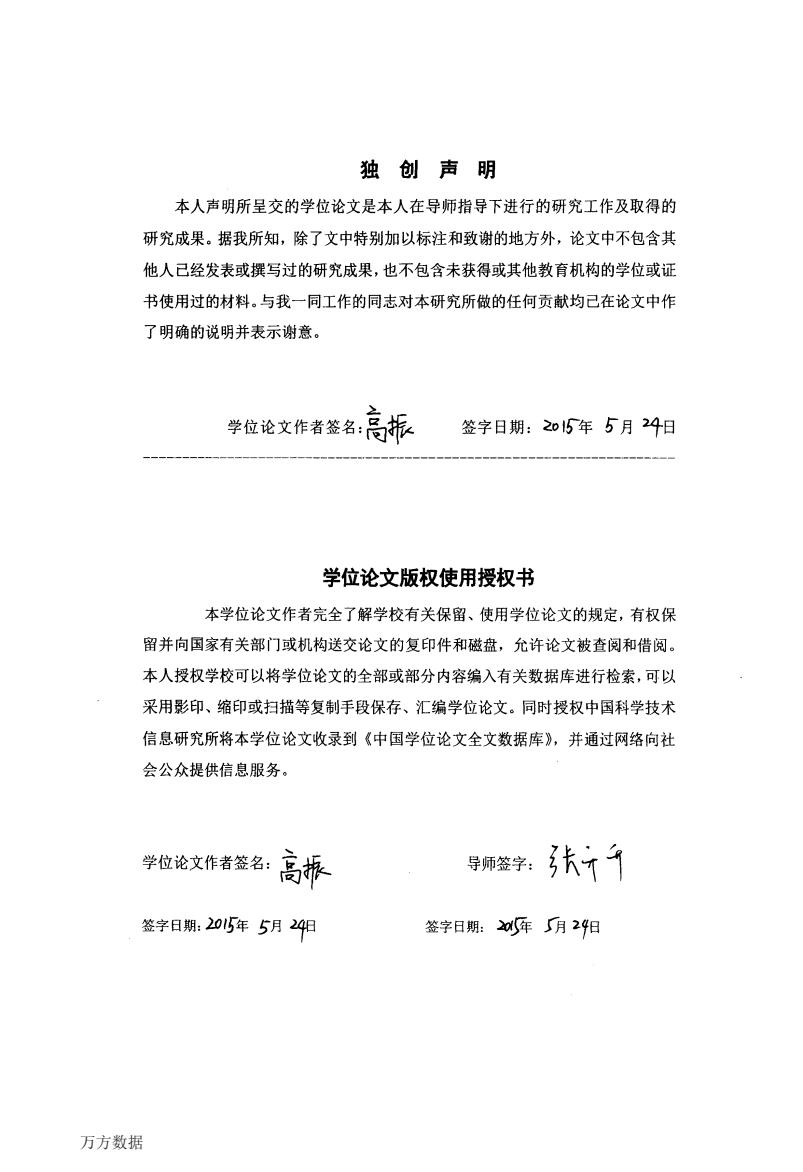
独创声明 本人声明所呈交的学位论文是本人在导师指导下进行的研究工作及取得的 研究成果。据我所知,除了文中特别加以标注和致谢的地方外,论文中不包含其 他人已经发表或撰写过的研究成果,也不包含未获得或其他教育机构的学位或证 书使用过的材料。与我一同工作的同志对本研究所做的任何贡献均己在论文中作 了明确的说明并表示谢意。 学位论文作者签名 高板 签字日期:2015年5月24日 学位论文版权使用授权书 本学位论文作者完全了解学校有关保留、使用学位论文的规定,有权保 留并向国家有关部门或机构送交论文的复印件和磁盘,允许论文被查阅和借阅。 本人授权学校可以将学位论文的全部或部分内容编入有关数据库进行检索,可以 采用影印、缩印或扫描等复制手段保存、汇编学位论文。同时授权中国科学技术 信息研究所将本学位论文收录到《中国学位论文全文数据库》,并通过网络向社 会公众提供信息服务。 学位论文作者签名: 高振 导师签字: 张 签字日期:205年5月24阳 签字日期: 20年月24阳 万方数据
独创声明 本人声明所呈交的学位论文是本人在导师指导下进行的研究工作及取得的 研究成果。据我所知,除了文中特别加以标注和致谢的地方外,论文中不包含其 他人已经发表或撰写过的研究成果,也不包含未获得或其他教育机构的学位或证 书使用过的材料。与我一同工作的同志对本研究所做的任何贡献均已在论文中作 了明确的说明并表示谢意。 学位论文作者签名:高椎 签字日期:之Dl眸扩月斗日 学位论文版权使用授权书 本学位论文作者完全了解学校有关保留、使用学位论文的规定,有权保 留并向国家有关部门或机构送交论文的复印件和磁盘,允许论文被查阅和借阅。 本人授权学校可以将学位论文的全部或部分内容编入有关数据库进行检索,可以 采用影印、缩印或扫描等复制手段保存、汇编学位论文。同时授权中国科学技术 信息研究所将本学位论文收录到《中国学位论文全文数据库》,并通过网络向社 会公众提供信息服务。 学位论文作者签名:禹据 导师签字: 乡长I’ 签字日期:勾僻岁月中 签字日期:劫毋珀2y日 万方数据

水平轴潮流能水轮机仿生鲨鱼鳍叶片的设计 及水动力性能研究 摘要 近年来,潮流能的开发越来越受人类重视,水轮机作为获取潮流能的常用装 置,它能将潮流能转化为叶片旋转的机械能进而通过发电装置产生电能。叶片作 为水轮机获能的关键部件,其性能直接决定水轮机的获能效率,翼型又是构成叶 片的基本元素,因此翼型的选取在获能研究中十分重要。本文从仿生学出发,在 水轮机叶片仿形技术的基础上,拟将鲨鱼鳍翼型的优异水动力性能应用到仿生翼 型叶片和组合翼型叶片的设计上,以期改进水轮机的性能。 论文以鲨鱼鳍为翼型获取对象,利用逆向工程技术将三维扫描点云进行处理, 得到鲨鱼胸鳍和尾鳍的构型曲面,然后应用Solid Works三维建模软件按一定比 例截取鱼鳍不同位置的翼型。再经过Profili软件选择高升阻比或高扭矩系数的翼 型,得到最优仿生翼型和组合叶片翼型。然后结合叶素动量理论、Wilson叶片设 计理论以及基于Matlab的叶片参数优化和坐标变换等过程,生成仿生叶片和组 合翼型叶片,进而建立起仿生鲨鱼鳍水轮机模型。 数值模拟是从仿真的角度分析水轮机的性能。论文采用CFD方法,其过程 包括网格划分、求解计算、后处理等。其中网格划分采用Gambit软件,并按要 求进行流体域、旋转域的设置:求解计算和后处理部分采用专业流体分析软件 Fluent进行处理。然后在变桨距情况下下对仿生叶片、组合翼型叶片和常规翼型 叶片进行水动力性能的对比分析并得到如下结论:在额定转速、额定流速下,仿 生叶片和组合叶片分别在桨距角为70°和60时,叶轮对转轴的扭矩达到最大值, 且均大于常规翼型叶片,比较前两者又可确定仿生叶片性能最佳。同时还分析了 不同叶片的压力场和速度场云图,并得到了相应结论。 在数值模拟的基础上,论文设计了无线遥控舵机控制的变桨系统,设计包括: 变桨距力矩及传动方式的研究、系统原理图设计、三维造型等过程。然后进行了 仿生叶片和组合叶片模型的加工、变桨系统的制造与装配以及实验设备、实验方 案的制定等,最终将通过下水实验的方式对几种叶片构成的水轮机进行水动力性 能的测试,并达到预期的实验效果:实验结果与数值模拟结果相差不大,趋势变 万方数据
水平轴潮流能水轮机仿生鲨鱼鳍叶片的设计 及水动力性能研究 摘要 近年来,潮流能的开发越来越受人类重视,水轮机作为获取潮流能的常用装 置,它能将潮流能转化为叶片旋转的机械能进而通过发电装置产生电能。叶片作 为水轮机获能的关键部件,其性能直接决定水轮机的获能效率,翼型又是构成叶 片的基本元素,因此翼型的选取在获能研究中十分重要。本文从仿生学出发,在 水轮机叶片仿形技术的基础上,拟将鲨鱼鳍翼型的优异水动力性能应用到仿生翼 型叶片和组合翼型叶片的设计上,以期改进水轮机的性能。 论文以鲨鱼鳍为翼型获取对象,利用逆向工程技术将三维扫描点云进行处理, 得到鲨鱼胸鳍和尾鳍的构型曲面,然后应用SolidWorks三维建模软件按一定比 例截取鱼鳍不同位置的翼型。再经过Profili软件选择高升阻比或高扭矩系数的翼 型,得到最优仿生翼型和组合叶片翼型。然后结合叶素动量理论、Wilson叶片设 计理论以及基于Matlab的叶片参数优化和坐标变换等过程,生成仿生叶片和组 合翼型叶片,进而建立起仿生鲨鱼鳍水轮机模型。 数值模拟是从仿真的角度分析水轮机的性能。论文采用CFD方法,其过程 包括网格划分、求解计算、后处理等。其中网格划分采用Gambit软件,并按要 求进行流体域、旋转域的设置;求解计算和后处理部分采用专业流体分析软件 Fluent进行处理。然后在变桨距情况下下对仿生叶片、组合翼型叶片和常规翼型 叶片进行水动力性能的对比分析并得到如下结论:在额定转速、额定流速下,仿 生叶片和组合叶片分别在桨距角为700和600时,叶轮对转轴的扭矩达到最大值, 且均大于常规翼型叶片,比较前两者又可确定仿生叶片性能最佳。同时还分析了 不同叶片的压力场和速度场云图,并得到了相应结论。 在数值模拟的基础上,论文设计了无线遥控舵机控制的变桨系统,设计包括: 变桨距力矩及传动方式的研究、系统原理图设计、三维造型等过程。然后进行了 仿生叶片和组合叶片模型的加工、变桨系统的制造与装配以及实验设备、实验方 案的制定等,最终将通过下水实验的方式对几种叶片构成的水轮机进行水动力性 能的测试,并达到预期的实验效果:实验结果与数值模拟结果相差不大,趋势变 万方数据

化一致,并能得到额定流速下不同桨距角对应的水轮机转速这一重要数据。 总之,本文的研究为水轮机叶片仿生翼型的选择提供了参考,为潮流能水轮 机叶片的设计提供了新的思路,揭示了仿生学在工程设计中的重要应用,对开发 利用和推广海洋能具有一定的指导意义。同时,论文的研究方法和数据结论也为 仿生学应用于潮流能水轮机的后续研究提供了参考价值。 关键词:潮流能;水轮机;仿生鲨鱼鳍;翼型;变桨系统 万方数据
化一致,并能得到额定流速下不同桨距角对应的水轮机转速这一重要数据。 总之,本文的研究为水轮机叶片仿生翼型的选择提供了参考,为潮流能水轮 机叶片的设计提供了新的思路,揭示了仿生学在工程设计中的重要应用,对开发 利用和推广海洋能具有一定的指导意义。同时,论文的研究方法和数据结论也为 仿生学应用于潮流能水轮机的后续研究提供了参考价值。 关键词:潮流能;水轮机;仿生鲨鱼鳍;翼型;变桨系统 万方数据
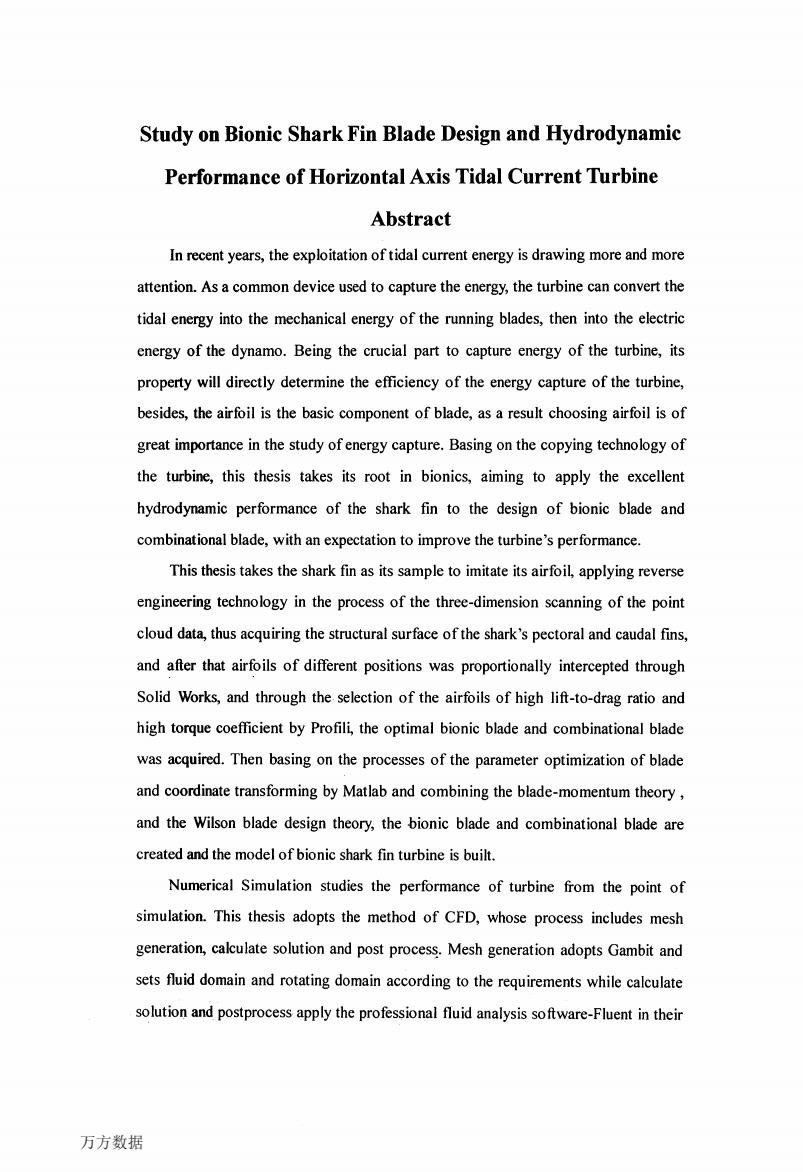
Study on Bionic Shark Fin Blade Design and Hydrodynamic Performance of Horizontal Axis Tidal Current Turbine Abstract In recent years,the exploitation of tidal current energy is drawing more and more attention.As a common device used to capture the energy,the turbine can convert the tidal energy into the mechanical energy of the running blades,then into the electric energy of the dynamo.Being the crucial part to capture energy of the turbine,its property will directly determine the efficiency of the energy capture of the turbine, besides,the airfoil is the basic component of blade,as a result choosing airfoil is of great importance in the study of energy capture.Basing on the copying technology of the turbine,this thesis takes its root in bionics,aiming to apply the excellent hydrodynamic performance of the shark fin to the design of bionic blade and combinational blade,with an expectation to improve the turbine's performance. This thesis takes the shark fin as its sample to imitate its airfoil,applying reverse engineering technology in the process of the three-dimension scanning of the point cloud data,thus acquiring the structural surface of the shark's pectoral and caudal fins, and after that airfoils of different positions was proportionally intercepted through Solid Works,and through the selection of the airfoils of high lift-to-drag ratio and high torque coefficient by Profili,the optimal bionic blade and combinational blade was acquired.Then basing on the processes of the parameter optimization of blade and coordinate transforming by Matlab and combining the blade-momentum theory, and the Wilson blade design theory,the bionic blade and combinational blade are created and the model of bionic shark fin turbine is built. Numerical Simulation studies the performance of turbine from the point of simulation.This thesis adopts the method of CFD,whose process includes mesh generation,calculate solution and post process.Mesh generation adopts Gambit and sets fluid domain and rotating domain according to the requirements while calculate solution and postprocess apply the professional fluid analysis software-Fluent in their 万方数据
Study on Bionic Shark Fin Blade Design and Hydrodynamic Performance of Horizontal Axis Tidal Current Turbine Abstract In recent years,the exploitation oftidal current energy is drawing more and more attention.As a common device used to capture the energy,the turbine can convert the tidal energy into the mechanical energy of the running blades,then into the electric energy of the dynamo.Being the crucial part to capture energy of the turbine,its property will directly determine the efficiency of the energy capture of the turbine, besides,the airfoil is the basic component of blade,as a result choosing airfoil is of great importance in the study of energy capture.Basing on the copying technology of the turbine,this thesis takes its root in bionics,aiming to apply the excellent hydrodynamic performance of the shark fin to the design of bionic blade and combinational blade,with an expectation to improve the turbine’S performance. This thesis takes the shark fin as its sample to imitate its airfoil,applying reverse engineering techno logy in the process of the three-dimension scanning of the point cloud data,thus acquiring the structural surface of the shark’S pectoral and caudal fms, and after that airfoils of different positions was proportionally intercepted through Solid Works,and through the selection of the airfoils of high lift-to-drag ratio and high torque coefficient by Profili,the optimal bionic blade and combinational blade was acquired.Then basing on the processes of the parameter optimization of blade and coordinate transforming by Matlab and combining the blade-momentum theory, and the Wilson blade design theory,the bionic blade and combinational blade are created and the model of bionic shark fin turbine iS built. Numerical Simulation studies the performance of turbine from the point of simulation.This thesis adopts the method of CFD,whose process includes mesh generation,calculate solution and post process.Mesh generation adopts Gambit and sets fluid domain and rotating domain according to the requirements while calculate solution and postprocess apply the professional fluid analysis software.Fluent in their 万方数据
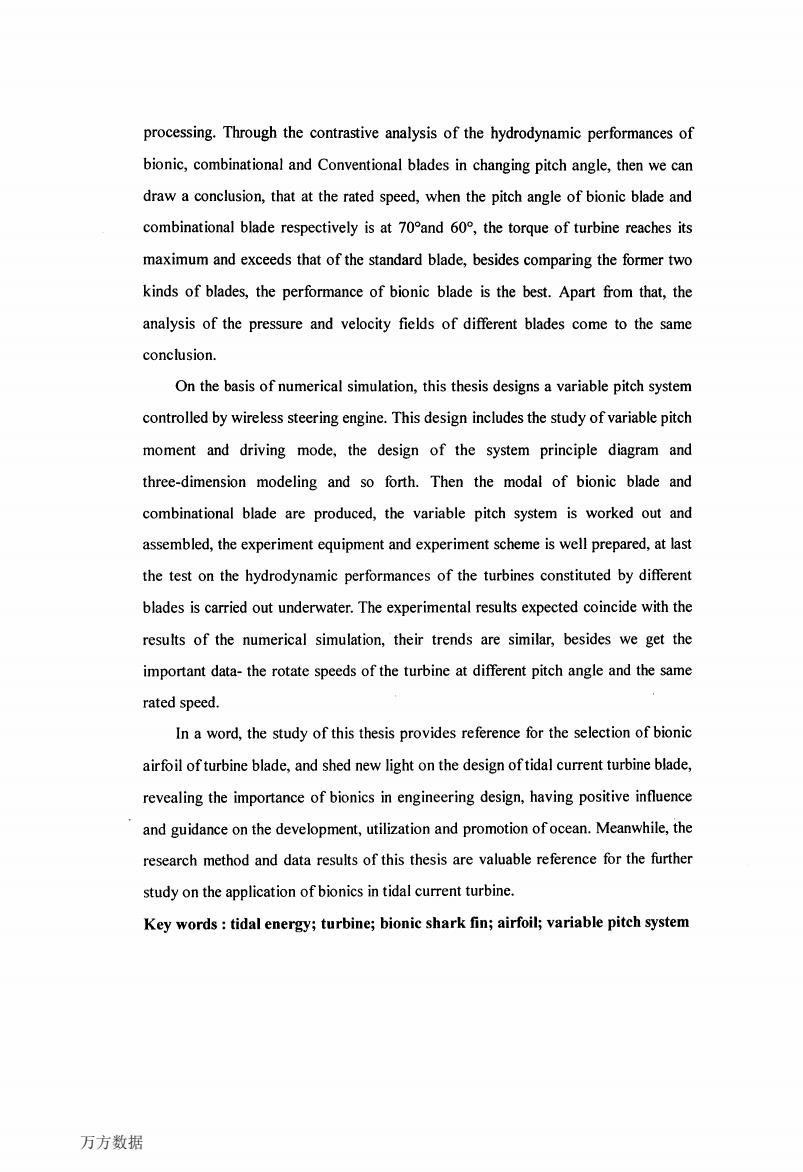
processing.Through the contrastive analysis of the hydrodynamic performances of bionic,combinational and Conventional blades in changing pitch angle,then we can draw a conclusion,that at the rated speed,when the pitch angle of bionic blade and combinational blade respectively is at 70and 60,the torque of turbine reaches its maximum and exceeds that of the standard blade,besides comparing the former two kinds of blades,the performance of bionic blade is the best.Apart from that,the analysis of the pressure and velocity fields of different blades come to the same conclusion. On the basis of numerical simulation,this thesis designs a variable pitch system controlled by wireless steering engine.This design includes the study of variable pitch moment and driving mode,the design of the system principle diagram and three-dimension modeling and so forth.Then the modal of bionic blade and combinational blade are produced,the variable pitch system is worked out and assembled,the experiment equipment and experiment scheme is well prepared,at last the test on the hydrodynamic performances of the turbines constituted by different blades is carried out underwater.The experimental results expected coincide with the results of the numerical simulation,their trends are similar,besides we get the important data-the rotate speeds of the turbine at different pitch angle and the same rated speed. In a word,the study of this thesis provides reference for the selection of bionic airfoil of turbine blade,and shed new light on the design of tidal current turbine blade, revealing the importance of bionics in engineering design,having positive influence and guidance on the development,utilization and promotion of ocean.Meanwhile,the research method and data results of this thesis are valuable reference for the further study on the application of bionics in tidal current turbine. Key words tidal energy;turbine;bionic shark fin;airfoil;variable pitch system 万方数据
processing.Through the contrastive analysis of the hydrodynamic performances of bionic,combinational and Conventional blades in changing pitch angle,then we can draw a conclusion,that at the rated speed,when the pitch angle of bionic blade and combinational blade respectively is at 700and 600.the torque of turbine reaches its maximum and exceeds that of the standard blade,besides comparing the former two kinds of blades,the performance of bionic blade is the best.Apart from that,the analysis of the pressure and velocity fields of different blades come to the same conclusion. On the basis of numerical simulation,this thesis designs a variable pitch system controlled by wireless steering engine.This design includes the study of variable pitch moment and driving mode,the design of the system principle diagram and three-dimension modeling and SO forth.Then the modal of bionic blade and combinational blade are produced,the variable pitch system is worked out and assembled,the experiment equipment and experiment scheme is well prepared,at last the test on the hydrodynamic performances of the turbines constituted by different blades is carried out underwater.The experimental results expected coincide with the results of the numerical simulation,their trends are similar,besides we get the important data-the rotate speeds of the turbine at different pitch angle and the same rated speed. In a word,the study of this thesis provides reference for the selection of bionic airfoil ofturbine blade,and shed new light on the design oftidal current turbine blade, reveal ing the importance of bionics in engineering design,having positive influence and guidance on the development,utilization and promotion ofocean.Meanwhile,the research method and data results of this thesis are valuable re诧rence for the further study on the application of bionics in tidal current turbine. Key words:tidal energy;turbine;bionic shark fin;airfoil;variable pitch system 万方数据
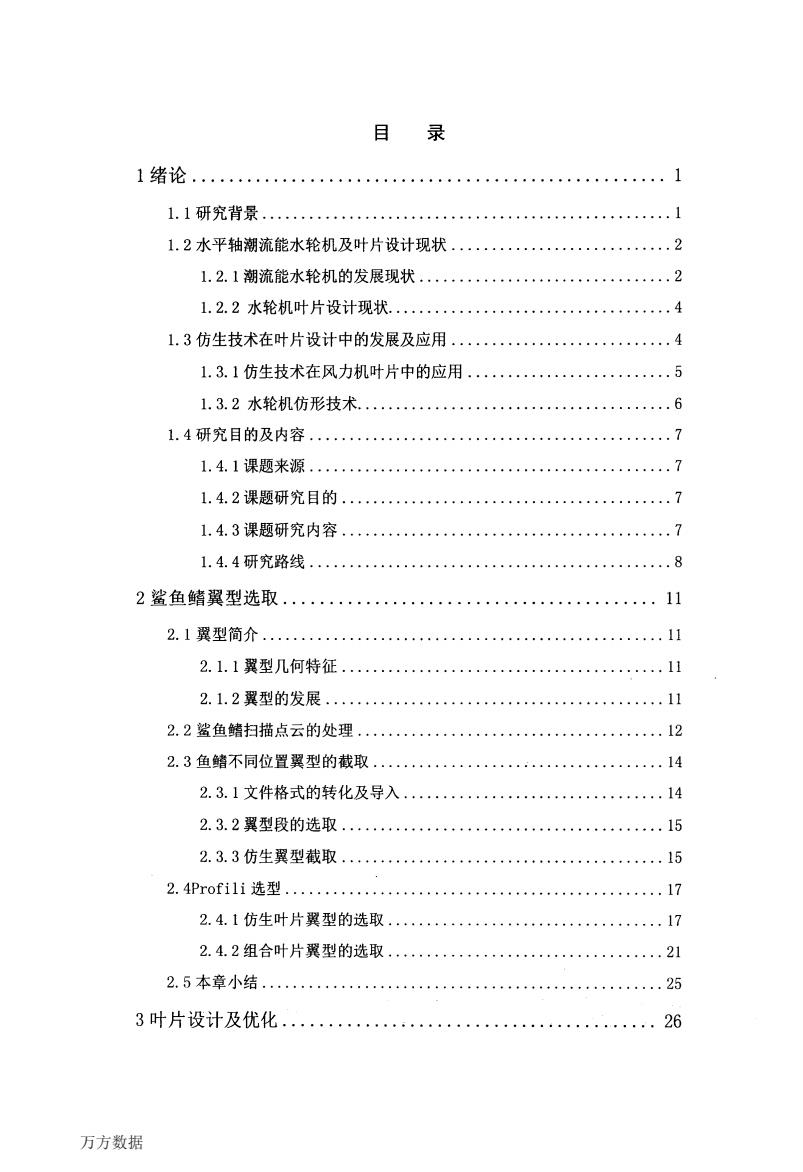
目 录 1绪论..… 1.1研究背景.… 1.2水平轴潮流能水轮机及叶片设计现状.. 2 1.2.1潮流能水轮机的发展现状.......2 1.2.2水轮机叶片设计现状..... 1.3仿生技术在叶片设计中的发展及应用........4 1.3.1仿生技术在风力机叶片中的应用........5 1.3.2水轮机仿形技术. ……6 1.4研究目的及内容 ….7 1.4.1课题来源.. ….7 1.4.2课题研究目的 .7 1.4.3课题研究内容.…. .7 1.4.4研究路线.. 2鲨鱼鳍翼型选取..·. 11 2.1翼型简介...… …11 2.1.1翼型几何特征..... 2.1.2翼型的发展. …………11 2.2鲨鱼鳍扫描点云的处理... 12 2.3鱼鳍不同位置翼型的截取.. ……14 2.3.1文件格式的转化及导入 ….14 2.3.2翼型段的选取.. ..15 2.3.3仿生翼型截取.... 15 2.4 Profi1i选型...… > 2.4.1仿生叶片翼型的选取 ,17 2.4.2组合叶片翼型的选取 …21 2.5本章小结.. 25 3叶片设计及优化... 26 万方数据
目 录 1绪论…………….………………………………1 1.1研究背景…………………………………………….1 1.2水平轴潮流能水轮机及叶片设计现状……………………….2 1.2.1潮流能水轮机的发展现状…………………………..2 1.2.2水轮机叶片设计现状………………………………4 1.3仿生技术在叶片设计中的发展及应用……………………….4 1.3.1仿生技术在风力机叶片中的应用……………………..5 1.3.2水轮机仿形技术………………………………….6 1.4研究目的及内容……………………………………….7 1.4.1课题来源….……………………………………7 1.4.2课题研究目的……………………………………7 1.4.3课题研究内容…………….………………..……7 1.4.4研究路线….……………………………………8 2鲨鱼鳍翼型选取…………………………………..11 2.1翼型简介……….………….…....…………………ll 2.1.1翼型几何特征…………………………………..11 2.1.2翼型的发展…………………………………….11 2.2鲨鱼鳍扫描点云的处理……….......…………………..12 2.3鱼鳍不同位置翼型的截取……….……….……………..14 2.3.1文件格式的转化及导入……….…………………..14 2.3.2翼型段的选取…………………………………..15 2.3.3仿生翼型截取…………………………………..15 2.4Profili选型……………….……………….…...….17 2.4.1仿生叶片翼型的选取………....……………..…..17 2.4.2组合叶片翼型的选取………..…………….……..21 2.5本章小结……………………………………………25 3叶片设计及优化..….………………………..…….26 万方数据
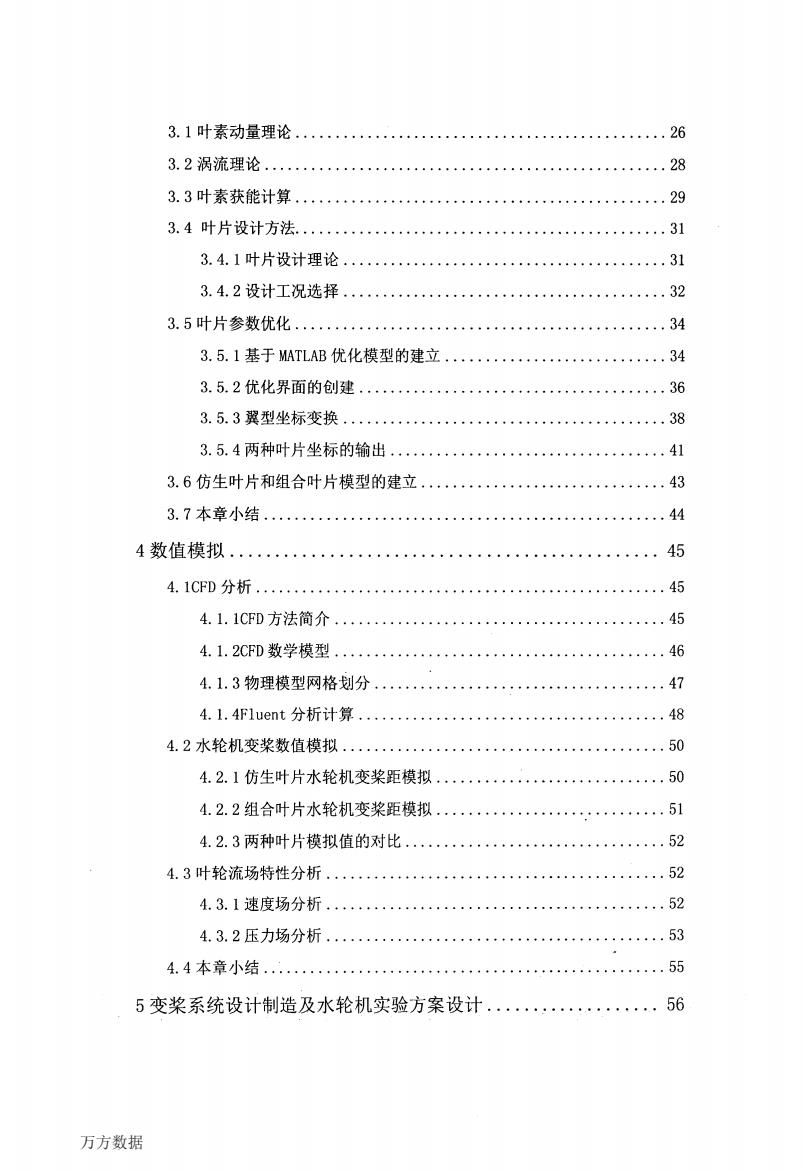
3.1叶素动量理论.… ….26 3.2涡流理论 .28 3.3叶素获能计算 .29 3.4叶片设计方法... 31 3.4.1叶片设计理论..31 3.4.2设计工况选择..... .32 3.5叶片参数优化...… …………34 3.5.1基于MATLAB优化模型的建立... .34 3.5.2优化界面的创建..... ………36 3.5.3翼型坐标变换...... 38 3.5.4两种叶片坐标的输出… 41 3.6仿生叶片和组合叶片模型的建立 43 3.7本章小结.. 44 4数值模拟... 45 4.1CPD分析 .45 4.1.1CFD方法简介..... 45 4.1.2CD数学模型.… 46 4.1.3物理模型网格划分 47 4.1.4F1uet分析计算,.,...48 4.2水轮机变桨数值模拟....... 50 4.2.1仿生叶片水轮机变桨距模拟.. .50 4.2.2组合叶片水轮机变桨距模拟. ..51 4.2.3两种叶片模拟值的对比..52 4.3叶轮流场特性分析., ......52 4.3.1速度场分析.. .52 4.3.2压力场分析.· .53 4.4本章小结. ,55 5变桨系统设计制造及水轮机实验方案设计...·56 万方数据
3.1叶素动量理论………………………………………..26 3.2涡流理论……..…………………………………….28 3.3叶素获能计算………………………………………..29 3.4叶片设计方法……………………….……………….31 3.4.1叶片设计理论…………………………………..3l 3.4.2设计工况选择…………………………………..32 3.5叶片参数优化…..……………………………………34 3.5.1基于MATLAB优化模型的建立……………………….34 3.5.2优化界面的创建…………………………………36 3.5.3翼型坐标变换…………………………………..38 3.5.4两种叶片坐标的输出……………………………..41 3.6仿生叶片和组合叶片模型的建立………………………….43 3.7本章小结……………………………………………44 4数值模拟………………………………………..45 4.1CFD分析…………………………………………….45 4.1.1CFD方法简介…………….……..………….…..45 4.1.2CFD数学模型……………………………………46 4.1.3物理模型网格划分…………………………….…47 4.1.4Fluent分析计算.………………………......…..48 4.2水轮机变桨数值模拟…………………………………..50 4.2.1仿生叶片水轮机变桨距模拟………..………………50 4.2.2组合叶片水轮机变桨距模拟………………………..51 4.2.3两种叶片模拟值的对比………………………......52 4.3叶轮流场特性分析…………………………………….52 4.3.1速度场分析....……………….………………..52 4.3.2压力场分析.………………………….…..……53 4.4本章小结……..….………...……………..……….55 5变桨系统设计制造及水轮机实验方案设计………一…..一.56 万方数据
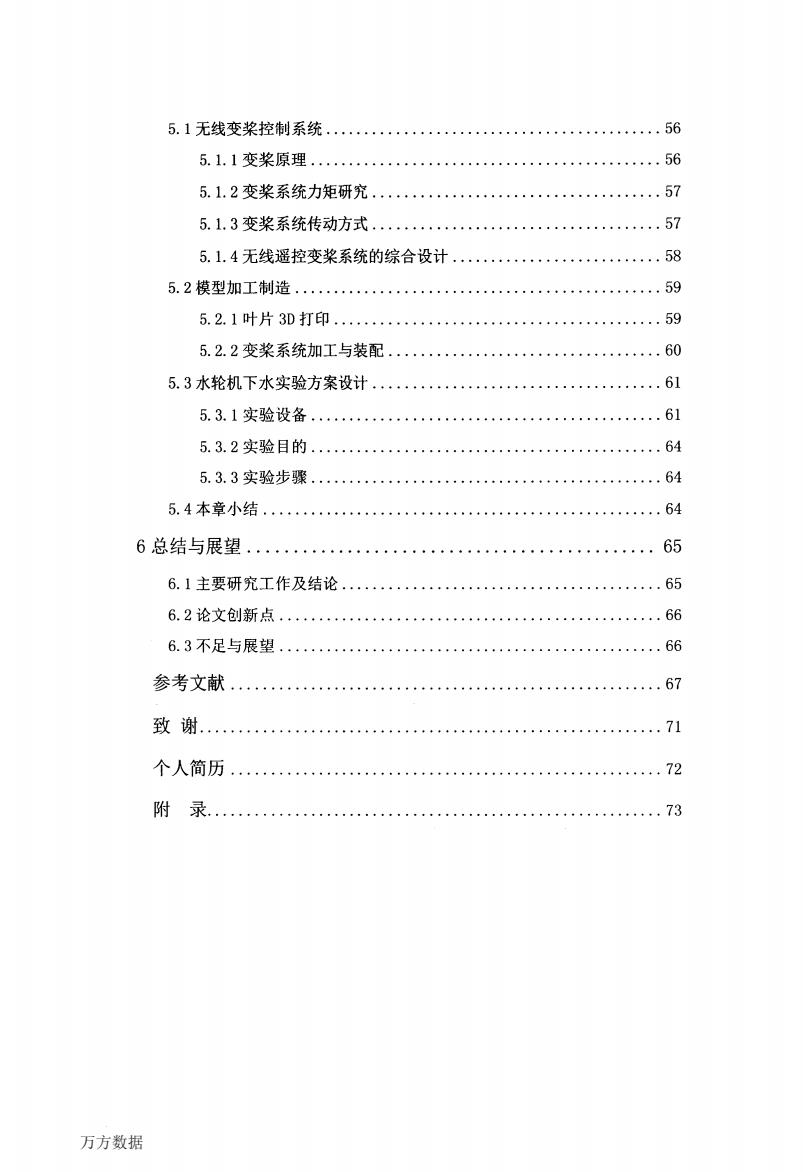
5.1无线变桨控制系统..56 5.1.1变桨原理.........56 5.1.2变桨系统力矩研究..57 5.1.3变桨系统传动方式… .57 5.1.4无线遥控变桨系统的综合设计......58 5.2模型加工制造.....… .59 5.2.1叶片3D打印.. 59 5.2.2变桨系统加工与装配 60 5.3水轮机下水实验方案设计 .61 5.3.1实验设备… .61 5.3.2实验目的... .64 5.3.3实验步骤. .64 5.4本章小结.…… 64 6总结与展望…… 65 6.1主要研究工作及结论 .65 6.2论文创新点 .66 6.3不足与展望. *66 参考文献 致谢.… .71 个人简历 ..72 附录. ,73 万方数据
5.1无线变桨控制系统…………………………………….56 5.1.1变桨原理………………………………………56 5.1.2变桨系统力矩研究……………………………….57 5.1.3变桨系统传动方式……………………………….57 5.1.4无线遥控变桨系统的综合设计………………………58 5.2模型加工制造………………………………………..59 5.2.1叶片3D打印……………………………………59 5.2.2变桨系统加工与装配……………………………..60 5.3水轮机下水实验方案设计……………………………….6l 5.3.1实验设备………………………………………61 5.3.2实验目的………………………………………64 5.3.3实验步骤………….…………………………..64 5.4本章小结……………………………………………64 6总结与展望………………………………………65 6.1主要研究工作及结论…………………………………..65 6.2论文创新点…………………………….……………66 6.3不足与展望…………………………….……………66 参考文献……………………………………………….67 致谢…………………………………………………..71 个人简历……………………………………………….72 附录………………………………………………….73 万方数据